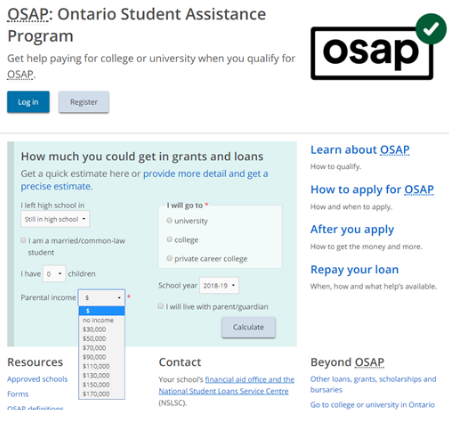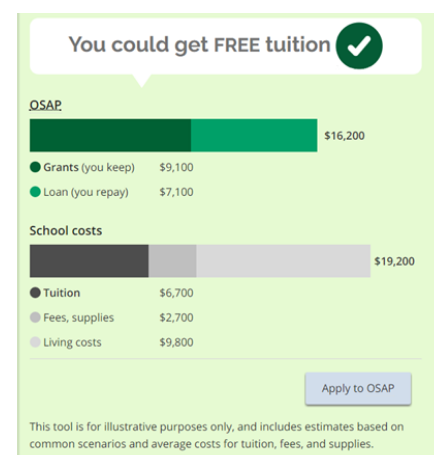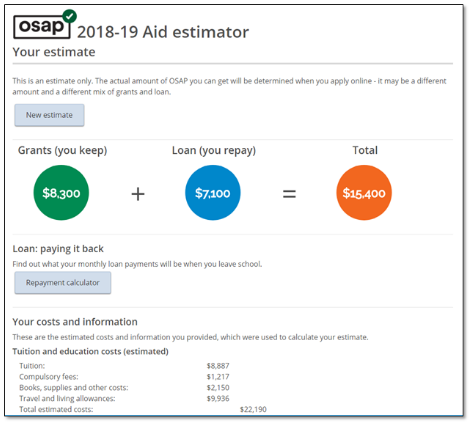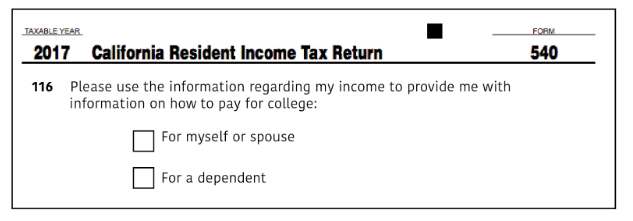Under a contract with the California Student Aid Commission, The Century Foundation (TCF) has been tasked with “identifying options for improving affordability at California colleges and universities,” and suggesting ways to streamline and consolidate existing programs “to reduce current students’ cost of attendance, thus reducing or eliminating the need to rely on student loan debt.”
The project team interviewed more than fifty stakeholders, including representatives from college access organizations, K-12 education, all of the higher education segments, several state agencies including the legislature, and others. Our recommendations focus on two major reforms: (1) consolidating the Cal Grant, while taking phased steps to improve overall affordability for low-income and middle-income students so that students have an option to take on little or no debt, and (2) scaling CSAC’s role in providing early, clear information to the public about student aid.
First, we recommend that California shift from a tuition-centric aid system to one that takes into consideration each student’s full college expenses when determining award levels. As part of that shift, we recommend updating the measurement of “need” and the related expected family contributions to be both more consistent across institutions and more realistic, particularly for low- and middle-income families, given the cost of living in California.
In order to accomplish this, the legislature would need to combine the major CSAC programs into one Cal Grant entitlement that would be available without regard to students’ age, time out of high school, high school GPA, or other factors that have severely complicated administration of, and communication about, Cal Grants. In addition, and over a reasonable time frame, the legislature would increase investment to better account for the total cost of attendance and to minimize both the debt and the in-school earnings Californians need to complete college. The legislature would implement the new aid system in three steps:
- Consolidate the Cal Grant and connect award level to the Expected Family Contribution (EFC). In Step 1, the legislature would broaden Cal Grant eligibility by combining all versions of the grant and eliminating current restrictions based on age, time out of high school, and GPA. A student’s amount of aid would take into consideration all college expenses rather than just tuition and fees. Institutional aid would supplement the Cal Grant at the University of California (UC) and the California State University (CSU) system and at many private colleges. We project Step 1 would begin to reduce students’ need for excessive work or loans at CSU campuses and community colleges. To ensure that students continue to have quality choices, students could use a Cal Grant at any private college that can meet quality assurance standards.
- Using updated EFC and cost of attendance methodology, set the Cal Grant award level to meet affordability targets. In Step 2, CSAC would address the mismatch between the high cost of living in California and the federal EFC assumptions that low- and middle-income families face. Additional grant aid would make it possible for more students to focus on their education rather than on work, or risk their future by taking on problematic forms of debt.
- Expand the Cal Grant to reduce or eliminate the need for loans. In Step 3, the state would continue to use reformed estimated cost of attendance and financial need calculations and provide adequate funding to reduce or eliminate students’ need for loans or excessive work. Depending on a students’ ability or desire to work, Step 3 would provide most students with a pathway to a debt-free degree.
Even as the legislature partners with CSAC to develop these steps toward greater affordability, we propose that they also launch a Fund for Innovation in College Affordability, so that CSAC can pilot and study approaches to addressing students’ specific challenges and identify areas to gain efficiencies that reduce the cost of attendance. For example, CSAC could explore initiatives such as providing transportation vouchers, offering free meals on campus (at least in the initial weeks) for new students at community colleges, pre-purchasing textbooks for key courses, expanding work-study opportunities, arranging for child care, or funding emergency aid program to cover unforeseen student needs. CSAC would expand any successful financial aid interventions in Step 3.
Second, we recommend that CSAC pursue a parallel reform track toward a modernized, technology-savvy approach to information and advising. We propose an upgrade to CSAC’s web presence, building online capabilities and a partnership with the state Franchise Tax Board to allow students to easily obtain personalized estimates of their aid eligibility and to compare aid award letters, and an increased role in advising and college savings initiatives. CSAC might, for example, work with administrators of Scholarshare, the California college savings plan, to develop communication strategies to encourage participation. This role will require a significant focus on public communications and outreach, building on CSAC’s existing outreach programs, to bring a sophisticated approach to reaching millions of students and families across the state.
|
Three Steps to Expanding Opportunity and Reducing Student Debt |
||||
| STATUS QUO AND RECOMMENDATION | STEP 1
Reconfigure the Cal Grant |
STEP 2
Implement Revised Measures of Expenses and Need |
STEP 3
Expand the Cal Grant to Meet Need |
|
|
Broaden & Expand the Cal Grant to Address Unmet Need |
Aid programs are very complicated to explain and administer | Broaden and strengthen the Cal Grant | →→→→→→→→→→ | →→→→→→→→ |
| Aid amounts are linked to tuition even though expenses go far beyond | Link aid to unmet need instead of tuition, providing enough funding to meet an initial affordability target | Increase funding to meet revised affordability targets | Provide funding to reduce or eliminate need for loans | |
| The measure of family ability-to-pay (EFC) is frequently unrealistic | Develop revised measure to account for high cost of living in California | Reduce EFCs to account for higher cost of living | →→→→→→→→ | |
| Aid available to community college students very limited | Expand Cal Grant availability | Adjust funding to account for revised EFC and cost measures | Provide funding to reduce or eliminate need for loans | |
| Estimates of non-tuition expense can be unreliable and inconsistent, and can create counterproductive incentives | Study non-tuition expenses and incentives, develop methodology for estimates | Implement new standardized cost -of-attendance methodology across sectors | →→→→→→→→ | |
| Perspectives regarding the role of loans vary widely among colleges and aid professionals | Examine the role of work and loans, and develop revised affordability targets | Implement revised affordability targets as part of aid estimates and award letters | Refine approach regarding the role of loans | |
|
Nine Additional Steps to Remove Barriers to Access and Affordability |
||||
| Status Quo | Recommendation | |||
| Spur Innovation and Support Choices | Adults who are considering returning to school have little access to reliable information about aid | Provide adults with access to reliable, comparative expense-and-aid information; Include certificate options in college price comparisons, and in advising | ||
| The reach of aid is frequently inadequate and/or too late to address barriers or influence plans and choices | Test and evaluate innovative approaches to aid. Implement large-scale pilots of outreach, advising, textbook provision, free meals for the first month of school, assistance accessing public assistance, and other efforts to address specific needs; Use lessons from pilots to inform design of aid | |||
| Aid programs strongly emphasize BA over other options | Allow Cal Grant for programs as short as four months (consistent with Pell Grants) | |||
| Fixed grant amount is awkward fit for widely divergent value of private college options | Expand Cal Grant availability, and implement value measures | |||
| Provide Better & Earlier Information | Aid programs are very complicated to explain and administer | Broaden and strengthen the Cal Grant | ||
| Colleges’ estimates of price and aid can be difficult to access and even harder to compare | Provide families with early, reliable, comparative expense-and-aid information | |||
| Colleges’ award letters are often difficult to decipher and compare | Identify or develop a web-based award comparison tool; Link schools’ awards to comparison tool | |||
| Too few counselors available to provide reliable financial aid advising | Upgrade website to make personalized information about aid prominent; Expand CSAC financial aid advising capacity | |||
| Some families that could save for college, don’t | Reach out to families when children are young to encourage them to plan for college | |||
Broaden and Strengthen the Cal Grant
Frequently, and especially at public institutions, students’ greatest needs are not related to tuition, but instead are generated by other expenses, such as books, food, housing, and transportation. The bulk of CSAC aid, however, is linked simply to tuition prices, without taking into consideration the full set of expenses students face in order to commit themselves to their studies. At the same time, the current Cal Grant includes a patchwork of grant types (A, B, C, and both entitlement and competitive grants) with a variety of eligibility requirements that create complexities for students, CSAC, and schools. The resulting aid system is too difficult to understand, and in some cases, creates cliff effects for students and families, or fails to reach students who have significant need.
We recommend consolidating the current grant types to one Cal Grant, while at the same time shifting from the current tuition-centered approach to one that focuses on the unmet needs that students face, including tuition and other expenses. To adequately address those needs, the federal methodology that is used to determine both a student’s or family’s ability-to-pay and the expenses they will face will need to be refined to better align the expectations of low-income and middle-class family contributions with the high cost of living in California.
At UC and CSU, simplifying the Cal Grant is made easier and less costly by the fact that those two systems supplement the Cal Grant with considerable amounts of institutional aid. At the UC in particular, delinking the Cal Grant from tuition and moving to meet need will require a rearrangement of aid between the Cal Grant and institutional aid, but not significantly more resources. At the CSU, meeting need over time will require some additional state investment.1 The needs of community college students are substantial and will also require additional investment. Over time, the legislature should increase the Cal Grant enough so that, combined with Pell and institutional aid, students at UCs, CSUs, and community colleges would have a viable pathway to attaining a degree with no or little debt.
Table 1
|
Grant Aid at California’s Public Institutions Currently Totals More Than $6.5 Billion |
|||
| University of California system | California State University system | California Community Colleges | |
| Undergraduate enrollment
(full-time equivalent) |
210,000 | 360,000 | 800,000 |
| Federal Pell Grants | $380 | $960 | $1,600 |
| Cal Grants | $860 | $610 | $100 |
| Institutional Aid3 | $800 | $600 | $800 |
|
Source: U.S. Department of Education (Federal Student Aid, and the National Center for Education Statistics, California Legislative Analyst’s Office, California Student Aid Commission, University of California Office of the President, California State University. |
|||
Closing eligibility gaps and connecting the Cal Grant to need requires a new approach at private colleges as well. We recommend setting the Cal Grant for private, nonprofit colleges at the maximum set for a UC Cal Grant, but taking steps to ensure that the state is not overpaying, given what students are getting.
Step 1: Reconfigure the Cal Grant
In Step 1 of our recommended plan, the legislature would replace the age, GPA, time-out-of-school, income, and asset requirements with a simple consideration of Expected Family Contribution (EFC), as determined through the FAFSA.4 Including age and GPA requirements makes little sense from a policy perspective – it leaves out thousands of adult students with need and adds dual, often inequitable academic requirements on top of school admission standards. We project that, if the legislature removed these unnecessary eligibility requirements, hundreds of thousands of students would become eligible for the new Cal Grant.
At UC campuses, CSAC would award a Cal Grant to all low-income and middle-income California resident undergraduate students, rather than just some. And rather than going mostly to students left out by the current Cal Grants, institutional aid instead would be provided to all eligible students on top of the Cal Grant, meaning nearly all of the recipients who would receive a tuition-level Cal Grant under the current design would receive at least as much total aid under the revised approach. At CSU schools, we expect a similar shift, with institutional aid building on top of the Cal Grant, rather than going mostly to students who were denied a Cal Grant. However, because the Cal State system is currently unable to cover all denied students through the State University Grant (SUG), the legislature would need to appropriate additional funding to ensure that, for each student, the Cal Grant and the SUG grant combine to provide the necessary level of aid. These investments mean that Step 1 would begin to reduce students’ reliance on debt at CSUs and academically harmful levels of work at both CSUs and community colleges.
There are a couple of different ways that this broadening of the Cal Grant at UC and CSU could be achieved; both should aim for the Step 1 affordability target: a limit on the amount of “self help” funds from work and/or loans expected from any California resident student. (For Step 1, we recommend a level no higher than the current UC guideline of $11,000.) The most viable method is probably to spread and stack. Under this approach, both the Cal Grant and institutional aid would be spread, based on need, across the broad population of California residents, with the maximum Cal Grant set and funded at a level such that the combination of all grant aid meets the affordability target. One downside of this approach is that at current funding levels the Cal Grant portion would wind up being lower than tuition, creating the false impression that grant aid had been cut. We recommend addressing this by having the institutions provide a match so that the Cal Grant is at the tuition level. Institutional aid would be stacked on top, addressing non-tuition expenses.
A second approach would be for the legislature to combine CSAC-provided grants and institutional grants into single grants that meet or approach the affordability target.
Both approaches base the Cal Grant award on the goal of providing enough grant aid to meet an affordability target that takes into account all college expenses rather than just tuition. While basing the grant on tuition provides a simple message, students face a much broader range of costs—fees, housing, food, books, supplies, and transportation—that ultimately determine whether college is affordable for them or not.5
The illustrations below show how the role of Cal Grants and institutional aid would shift.
Figure 1.
Many Low-and Middle-Income Californians Are Denied Cal Grants.

Figure 2.
UC and CSU Provides Grants to Students Denied Cal Grants.

Figure 3.
Under Step 1 the Cal Grant Would Be Provided More Broadly, with UC and CSU Aid as a Supplement.

Figure 4.
In Steps 2 and 3, Additional Funding Would Support More Non-Tuition Expenses.

Community College Students
Community colleges enroll more low-income Pell Grant recipients than do CSU, UC, and California’s nonprofit colleges combined.6 Yet CSAC’s aid programs currently provide little support to community college students, and the community colleges lack the means to generate institutional aid in the way that UC and CSU do. While we view Step 1 of our reform proposal to be largely a rearrangement of aid to students attending UC and a modest increase in aid for CSU students, we recommend a significant expansion of aid at the community colleges. Taking into consideration a student’s full estimated cost of attendance, the legislature should provide a Cal Grant Award to community college students for whom the Pell Grant (if any) and their EFC leaves more than $8,000 of unmet need.7
The strict four-year duration of the Cal Grant creates complications for community college students, who frequently find that there are additional courses they need either before or after transfer. Using up more than two years of their eligibility at the community college, however, means they do not have even two years of aid left for the four-year institution. The legislature should consider providing an additional semester or two of eligibility to address this problem.
Additional Eligibility Changes
We recommend that when the legislature consolidates the Cal Grant and removes age, time-out-of school, GPA, and non-EFC income and asset requirements, it also harmonizes eligibility with most aspects of the Federal Pell Grant program. Cal Grants would be:
- based on the EFC rather than separate income and asset cutoffs;
- available to transfer students, whenever they transfer;
- available for any degree or certificate program that is Pell eligible (which includes programs as short as about a semester); fully available in the freshman year; and
- based on a requirement that recipients make satisfactory academic progress, but with no specific grade point or test requirement for initial eligibility (other than what is required to be admitted to the college).
However, we recommend the Cal Grant maintain some differences from the Pell Grant program. The legislature should make Cal Grants:
- available for the equivalent of two years at a community college and four years total (rather than the Pell Grant’s six years);8
- available only to California residents; include Dreamers;9
- tailored to specific institutions or segments; and
- reach higher levels of family income than Pell grants.
We recommend seeking additional input on other aspects of alignment with Pell grants, including availability to students without a high school diploma (in limited circumstances consistent with federal ability-to-benefit provisions); allowing for acceleration, as “summer Pell” does; and eliminating or changing the March and September application deadlines.
Step 2: Implement Revised Measures of Expenses and Need
Under Step 1, the level of the Cal Grant would be based on aiming for the current affordability target at both UC and CSU, and expanding Cal Grants to far more community college students also based on current need measures. Under Step 2, the state would implement revised measures of available family resources and expenses, and would establish the Cal Grant level and affordability targets based on those revised measures.10
Revise the Expected Family Contribution
Many Californians live in high-cost areas. But federal estimates of family resources available for college (the EFCs) do not take into account geographic differences in cost of living, making them potentially unreliable for many low-income and middle-class Californians. For example, a family of four earning $90,000 in expensive areas of California faces far higher housing costs than a family of four in other parts of the country. At least one state has taken steps to address this flaw: for its state aid, Maryland uses an EFC that is adjusted based on regional cost of living differences.11
We recommend that CSAC analyze the question of adjustments to the federal EFC during Step 1, and implement a revised version of the EFC in Step 2 to use in determining state aid. One regional approach to consider is to use the “commuting zones,” developed as an alternative to political boundaries.12 The regional difference in cost of living could easily be inserted into the appropriate place in the federal formula used to determine financial need.13
The revised EFC would not apply to federal aid, but developing and using a better approach for state aid establishes a foundation for a possible change at the federal level in a future reauthorization of the federal Higher Education Act.
Standardize Cost of Attendance Estimates
CSAC should establish a standardized methodology—one that takes regional cost of living differences into account—to determine the cost of attendance (COA). Doing so will ensure both that students receive aid that more consistently addresses the costs they face and that the new system does not create problematic incentives when schools set costs.14
There are currently wide variations in calculating student budgets by institution and sector. For example, the UC system accounts for housing and food costs that students incur when living at home with parents, recognizing that many students must still contribute to the household. The CSU system does not seem to account for those costs at all. Budgets for books and supplies also vary widely across institutions. It is an important role for CSAC, which should examine students’ actual experiences, to make recommendations for improving the accuracy of the estimates, work with institutions to use new estimates, and oversee the implementation of these more standardized COA estimates across the public system.
One of the hazards of pegging a grant to a cost of attendance as defined by the institution is that it can encourage (or at least fail to discourage) institutions to offer or require costly components, such as expensive dorms or high-priced textbooks. Alternatively, institutions may lowball certain cost-of-attendance figures to make the college seem more affordable than it really is, if they are trying to meet affordability targets. Under a standardized approach, an institution that manages to keep dorm costs low would not have aid taken away from students; instead, CSAC’s comparison tools would flag that the institution is more affordable than other institutions. Likewise, an institution that has instituted programs of free or low-cost textbooks or computers will be able to show that available aid goes farther than at schools with higher costs.
Depending on how cost of living is set, a more standardized system may also create unintended consequences for the ways in which students make decisions. For example, the new system should not structure cost of living budgets in a way that might discourage a student from economizing and living at home if they had planned to do so. CSAC would need to address those kinds of challenges in building the cost of attendance methodology. More detailed recommendations on how to do that are included in Appendix 7.
Step 3: Expand the Cal Grant to Reduce or Eliminate the Need for Loans
In Step 3, CSAC would analyze the changes to the EFC and cost of attendance and adjust further, if necessary. Meanwhile, we recommend that CSAC experiment with ways of providing for students’ needs (see the Fund for Innovation in College Affordability below), leading to possible suggestions for altering approaches to aid in a particular segment or more broadly. Finally, based on an analysis of the gaps that remain in the system of financial aid, in Step 3, the legislature would provide the funding to reduce or eliminate the “loan and work expectation” in the system, providing a pathway to a degree with no or little debt for most students.
It is important to note that, even if the legislature provided enough funds to eliminate the calculated need for loans, loans would still be necessary in the system. Students may choose to borrow instead of working the hours assumed in self-help work expectations, and it may be difficult for some students, particularly in certain regions, to schedule the work hours needed or to find full-time work over the summer, for example. Students may choose a more expensive dorm or meal plan, or accept an unpaid summer internship rather than work to earn money for college expenses. And parents of dependent students may not be able or willing to fund their full calculated EFCs. CSAC should consider playing a role in ensuring that the loans that students do take out are fair and manageable.
II. Spur Innovation and Support Quality Choices
While college affordability is about money, it is also about choices that colleges and students make. Nudging those choices in constructive directions may require CSAC and the legislature to take new approaches. Here we suggest some shifts to consider, and recommend creating the capacity to test innovative approaches.
Not Just Bachelor’s Degrees!
Currently the Cal Grant is geared almost exclusively to four-year degrees, except for the very small Cal Grant C program. We recommend that the Cal Grant at community colleges allow and even encourage the completion of certificate and associate’s degree programs, whether vocational or transfer-oriented. Furthermore, students who use a year or two of their Cal Grant eligibility for those programs should be able to claim the remainder of their four years of Cal Grants at a four-year college, whether or not that was their original intention.
Experiment with Innovative Approaches to Aid
Even as the legislature and CSAC pursue a phased approach to delinking the Cal Grant from tuition and connecting it to unmet need, and then updating the EFC and standardizing cost of attendance estimates, CSAC and schools should continue to pursue additional ways in which to bring down costs in the system and best serve low-income students. We recommend that during Step 1, the state make a large, nonrecurring investment in a Fund for Innovation in College Affordability. The fund would be used to test and evaluate creative approaches to providing aid to low-income or struggling students. These pilots are particularly needed at community colleges, but should not necessarily be restricted to that segment.
An important value of California community colleges—and one that the legislature should maintain—is their open, “ungated” design. They are for anyone who wants a formal learning opportunity, whether as part of a plan hatched in high school, the sudden result of a disruptive event such as losing a job, or a simple impulse to give college a try. But this open door policy often means that entering students have not completed all of the paperwork needed for aid. The state could use this fund to pilot various approaches to the challenge of walk-on students, such as first-term-first-day textbook programs for all students, free meals for the first month of classes, transportation buddy programs, and other initiatives.
As CSAC and campuses learn from these approaches over time, in Step 3, it may be appropriate to replace traditional aid approaches with different designs in some circumstances (for example, having arranged meals for community colleges at the beginning of the term, or pre-purchasing textbooks for common first-term classes).
Cal Grants at Private Colleges
We recommend that CSAC allow students to use these new Cal Grants at private colleges—as they currently do—but also recommend that CSAC ensure that the amount of the grant is not excessive, given the school’s spending on student instruction.
Public vs. Private Institutions
At California’s public institutions, the state has direct or indirect control over every aspect of the colleges’ operations. There is an annual negotiation over funding levels, but ultimately, state administrators determine the number of California residents who will be served, the level of enrollment of low-income students, the level of core support provided through appropriations, the tuition to be charged, the Cal Grant that helps some students pay tuition, and the amounts and targets of institutional aid. For the most part, salaries and budgets are transparent, and virtually everything the institutions do is subject to a potential state audit.
In short, in the context of the public institutions, the chance of public debate about the colleges’ spending decisions is high, but the hazard of the public purse being unwittingly taken advantage of is relatively low.
With institutions not operated directly or indirectly by the state, however, there is the potential for a third-party-payer problem: it is difficult for the payer to hold the institution accountable, leaving taxpayers and the students vulnerable. Should private colleges make any particular affordability commitment to students receiving state aid? Should highly selective institutions be expected to enroll a critical mass of low-income students, or community college transfers, to be eligible for state support? What level of quality should be expected for the state investment? We recommend that, at a minimum, the state attempt to address the latter question, assuring that a school is providing value for the money.
Strengthening Protections for California’s Expanded Investment
The original purpose of the Cal Grant program included tapping the private nonprofit colleges at a time when the public four-year institutions did not have the space for every eligible Californian. Many colleges are serving exactly that role—and while a few outlier private colleges have very large endowments that they could use to support low-income students, most do not. At the same time, there is a wide range of variability in the return that the state is getting on their Cal Grant investment: while many colleges spend far more per student on instruction than they receive in Cal Grant funds, at some colleges, the Cal Grant exceeds the amount spent per student on instruction by more than a factor of two, suggesting that taxpayers may be overpaying. Expanding Cal Grant eligibility means an increase in the potential taxpayer cost and risks beyond the current system.
CSAC should continue to provide Cal Grants to students attending private nonprofit colleges, and set the maximum award based on the Cal Grant for UC (depending on how it is designed). In order to ensure that student aid dollars are going to the intended target—teaching and supporting students—the award amount should not be higher than an institution’s average per-student spending on instruction. Institutions are already required to report those instructional cost numbers to the federal government.
CSAC could, over time, research and assess alternative protections for the state’s investment. For example, CSAC could consider limiting Cal Grant usage at private colleges to those that have demonstrated that their tuition price is not based on aid availability.15 A different approach could be to offer Cal Grants only to students who demonstrated enough academic preparedness that they were admitted to at least one CSU or UC, or demonstrated that they compared their options by applying to CSU or UC. This would, in effect, mean that the state would rely on public community colleges to serve as the state’s open access institutions.
The Cal Grant is currently restricted to private colleges located in California. Opening up the program to colleges across the country would present a major oversight burden on CSAC, and would provide little added benefit in terms of the diversity of choices available to students. One possible exception, however, is HBCUs, which advisors told us are of particular interest to some African-American high school students. We suggest CSAC explore the idea of HBCU eligibility for Cal Grants in some circumstances, perhaps starting with transfer students.16
For-Profit Colleges and Similar Institutions
The financial restrictions and accountability requirements of public and nonprofit institutions have long been successful regulations in terms of preventing consumer abuses. The financial incentives that can drive for-profit institutions to become predatory are restrained at public and nonprofit institutions, where trustees cannot have a financial interest in the schools’ profit margins, and revenues must be reinvested toward the school’s educational or public-serving mission. Absent these restraints, enrollment at for-profit institutions, particularly when financed by third parties through government grants and loans, disproportionately leads to:17
- Decreased student earnings: On average, students attending for-profit programs have a negative return to attending college, according to one study. And, those that were employed after leaving college earned less than if they had gotten a job and not enrolled.
- Growing debt balances: Nearly three-quarters of students who borrowed federal loans to attend for-profit colleges owe more on their loans two years after leaving school than they did when they left, due to accrued interest and fees. Even among graduates, only 36 percent of federal student loan borrowers from for-profit colleges have made a dent in their debt three years after leaving college—half the rate of graduates from public or nonprofit colleges (71 and 74 percent, respectively).
- Unmanageable debt loads: Federal standards measure whether the debt loads of career education program graduates are reasonable given their post-college earnings. Because they typically have higher costs and lead to lower graduate earnings, virtually all (98 percent) of the programs that fail this test are at for-profit colleges. (More than a third of the rated programs were offered by nonprofit or public institutions.)
- Loan default: For-profit colleges account for one-third of federal student loan defaults, despite enrolling just 9 percent of students. Of students who borrowed at for-profit colleges in 2003–04, for example, more than half had defaulted during the twelve years that followed.
- Student deception: Borrowers who have been misled, defrauded, or otherwise wronged by their college can petition to have their federal loans discharged. Former for-profit college students account for 99 percent of all such discharge applications.18
If there are reasons to risk tax dollars on institutions that choose to operate as for-profit entities, the current grant level and consumer protections should be maintained while the state considers additional provisions to ensure that students and taxpayers are receiving adequate value. Furthermore, if an institution claims to be nonprofit, CSAC should ensure that it is complying with the requirement that all revenue be dedicated to educational or charitable expenses, and no trustee or key employee is taking the equivalent of profits.
III. Provide Better and Earlier Information
We recommend that CSAC significantly scale its role in providing personalized, easy-to-understand information to students and families across California. Specifically, we recommend that CSAC modernize its website, make available information about aid personalized and easy to find and understand, and create the functionality to allow students to easily compare financial aid award letters. Doing so will complement changes in the aid program discussed earlier, but could have a significant effect on college-going across the state even without changes to the Cal Grant.
Background
Compared to other states, California does a commendable job of making college affordable. Tuition for in-state community college students is the lowest in the country, and is waived for almost half of students. Tuition is also relatively low in the nation’s largest four-year public system, the California State University (CSU) system. Average tuition and fees at public master’s universities across the nation are $8,670 in 2017–18. CSU charges about $6,600. Even at the University of California, with tuition and fees of about $14,000, compared with an average of $10,830 for public doctoral universities nationally, the combination of Cal Grant awards and institutional aid results in net prices and student loan debt levels that are below the national average.
Providing aid to needy students who have already made their decisions about where and how to enroll in college will reduce the need to work long hours and borrow, and can enhance the likelihood that students succeed. But a financial aid system has an important role to play before matriculation: to influence those decisions in the first place, by making it possible for students to enroll at the colleges that best fit their needs and interests, to work less in college so that they can study more, to get the computer equipment and textbooks they need without delay, and not to be distracted by difficulties addressing basic needs, such as food or adequate housing.
Many students and parents dramatically overestimate the price of postsecondary education.19 Showing them their estimated aid and net price and helping them apply for aid makes them more likely to complete the aid application process for aid and enroll in college.20
The college expenses that a family will face should not be a mystery that is revealed months after the college application deadlines and only days before they have to make decisions. Families, especially those of limited means, need reliable information, personalized to their financial situations, at least as early as a child’s junior year in high school, and ideally even earlier. Adults without a college degree, too, need to be able to get information about aid without relying on recruiters who may not always have the students’ best interests in mind.
Create a User-Friendly Website
We recommend CSAC update its website to make more personalized and complete information a prominent feature. As possible models, the financial aid agencies of Ontario, Canada,21 and Oregon22 are noteworthy for their simplicity, thoroughness, and usability. These websites also allow users to easily create good estimates of expected financial aid and total price of attendance before and after aid and direct them to apply for aid. The home page of the Ontario Student Assistance Program features a questionnaire that quickly estimates financial aid and net price of attendance after users enter seven elements of information: high school graduation year, marital status, number of children, approximate parental income, institution type, year expected to start postsecondary education, and whether the student will live at home with a parent (see Figure 5). In addition to these estimates, the website displays a link to apply for financial aid.
Figure 5

The Ontario calculator has a list of incomes to choose from in wide bands (though each is represented by a single number), so users do not need to know the precise amount. To illustrate, Figure 6 shows the initial financial aid and net price estimate that appears if users identify as a current high school senior (the default option) with a parental income around $50,000 (Canadian), planning to attend a university (as opposed to a college or private career college). This estimate appears after users enters only two pieces of information. The values adjust if and when users select other options, such as a different school year or living arrangement.
Figure 6

Figure 7 shows the results of a “precise estimate” for a dependent student with an income of $55,000 planning to attend McMaster University as a freshman in computer science. The functionality is similar to the net price calculators provided by most U.S. institutions as required by the Higher Education Opportunity Act of 2008.23 In the Ontario case, however, the calculator is provided by a government agency that allows users to generate estimates for multiple institutions from the same website, whereas users in the United States must visit individual institutions’ websites or perhaps use a third-party service that aggregates estimates across multiple institutions.24
Figure 7

In addition to making CSAC’s website more user-friendly, there needs to be more coordination across state agencies in terms of information about college options and financial aid. Figure 8 shows a website launched recently by the California state agency that assists students who have been the victims of predatory postsecondary schools. With links for “student assistance” and “researching colleges,” it could easily be confused as the place to go for information about college options in the state and how to pay for them.
Figure 8

Education Could Easily Be Confused for CSAC. Source: Office of Student Assistance and Relief, http://www.osar.bppe.ca.gov/.
Make Estimates and Comparisons Easier
California should go further than Ontario in the college price and aid information it makes available to its residents. First, the state should develop a partnership with the California Franchise Tax Board, working with them to add a simple check-box to the state income tax form requesting a financial aid estimate for a child or for an adult. Just with the information available to the state on the income tax form, CSAC would be able to produce a fairly precise financial aid estimate for most families in the state.
Second, CSAC should also provide estimates for multiple sample institutions, such as a nearby community college, a CSU campus, a UC, and, if possible, a private nonprofit college. Our research showed that many low-income families do not know, or do not believe, that tuition costs at four-year colleges, after aid, may be as low as those at community colleges. Estimates could even include information about certificate programs below the baccalaureate level, particularly relevant for adults already in the workforce.
Figure 9

Providing personalized, comparative aid estimates can help to expand the options that low-income families consider. The information must be provided early, though, so that the students do not miss required courses or admissions application deadlines.
Improve and Compare Financial Aid Award Letters
CSAC should use this improved web presence to allow students to compare aid awards across institutions. Award letters are often difficult to decipher and compare; at times, different schools might call the same grant by different names, or even make it hard for students to determine which award is a grant and which is a loan. CSAC should consider building the functionality within its web portal that would require schools to enter their aid award information into a predetermined format in order to participate in the Cal Grant program. Students could then login into their personal CSAC page to easily compare aid awards. Doing so would also allow CSAC to analyze aid data over time and better understand which students face gaps within sectors across the state.
Follow Up with Assistance and Advising
CSAC can do more than provide information about colleges, aid, and prices by supporting students through the aid application and enrollment processes. As increasing amounts of information about individual institutions and programs become available online, students need more than just better information: they need guidance in choosing appropriate paths given their goals, academic preparation, and circumstances. But many institutions, particularly public high schools, are insufficiently staffed to provide such support, with student-to-counselor ratios as high as 1,500-to-1.25
Evidence is mounting that simple, low-to-modest-cost coaching interventions that reach out to students during the summer after high school and throughout the first year of college can have substantial effects on enrollment and persistence. For example, a series of randomized experiments found that text messaging, peer mentoring, and proactive outreach were all successful at reducing “summer melt”—students who secure enrollment but never show up—with costs of no more than $200 per student served.26 While personalized services would be more expensive, existing research suggests the impact may justify the cost.27
Prior to enrollment, coaching services may help students interpret aid award letters and prioritize tasks and paperwork required to complete the enrollment process.28
CSAC should pilot low-cost initiatives to identify successful interventions, starting with a focus on students likely to have the greatest financial need, as identified through CSAC’s partnership with the state Franchise Tax Board.
Encourage and Facilitate Saving for College
Helping a low-income family with young children to open a college savings account can be an effective way of encouraging the parents to assume that college is in the child’s future, and to start setting aside money so that it can grow with interest. The San Francisco Unified School District puts $50 into an account for every kindergartner, and similar programs are being considered in other cities.29 There is still much to learn about the potential impact and optimal design of these types of programs. CSAC should partner with these efforts to provide useful information about college costs and aid, and to identify and test ways to inform college plans in the years between kindergarten and the senior year of high school.30
Low-income families should not be the only targets of college-savings efforts. Middle- and higher-income families frequently feel the squeeze of college costs and realize they should have saved more during the prior decade. And low-income families do not have much disposable income to draw on for savings, while higher income families do. By encouraging saving by higher income families CSAC would be helping to address college affordability challenges well into the future. At a minimum, information could be provided through the partnership with the Franchise Tax Board.
Conclusion
California has a proud history of commitment to broad college access and excellence. Perhaps more than any other single factor, the state’s economic strength is the result of its leadership in higher education. Maintaining that leadership requires continuously updating our approach to adapt to current needs. In financial aid, that means recognizing where our systems have failed to provide the information and support needed to foster both access to college and completion of a degree. This report lays out steps for filling the gaps in the state’s current system of financial aid by providing families with earlier and more complete information about paying for college, and ensuring that the aid is sufficient to make it possible for students to engage in college without taking on crippling debt.
Appendixes
- Appendix 1: Fiscal Analysis
- Appendix 2: Communications Plan
- Appendix 3: Reforms in Other States and Countries
- Appendix 4: Stakeholder Perspectives on CSAC Programs and the Grant Delivery System
- Appendix 5: Analysis of Administrative Steps
- Appendix 6: Summary and History of California Financial Aid Programs
- Appendix 7: Cost of Attendance
- Appendix 8: Legislative Specifications
The California Student Aid Commission contracted with The Century Foundation to produce this report. The authors consulted with David Radwin, Elisabeth Hensley, and Erin Dunlop Velez at RTI International, as well as Craig Yamamoto, a former financial aid administrator with decades of experience. In addition, a team of advisors with expertise in financial aid gave input on the recommendations. The advisors included: Debbie Cochrane, The Institute for College Access and Success; Sara Goldrick-Rab, Temple University; Mark Huelsman, Demos; Deborah Santiago, Excelencia in Education; Michele Siqueiros, Campaign for College Opportunity; Evan Weissman, MDRC.
Notes
- More than a third of California community college students live at home with a parent, though many of those students still have substantial expenses and may be expected to help support the household. One-third figure based on an analysis of the data from NPSAS 2007-8: 35 percent of California community college student lived at home with a parent. NPSAS:08 results (translating to about 699,000 out of 2,018,000 students that year)
- Pell Grant figures are totals from U.S. Department of Education school data for 2015–16 (California for-profit colleges receive $575 million and nonprofits $250 million). Cal Grant data are from CSAC for 2017–18; an additional $230 million goes to private colleges. FTES enrollment figures are from UCOP and CSU reports and, for the community colleges, the National Center for Education Statistics (https://nces.ed.gov/programs/digest/d16/tables/dt16_307.20.asp).
- “Creating a Debt-Free College Program,” Legislative Analyst Office, January 31, 2017, http://www.lao.ca.gov/Publications/Report/3540. Figures are for the UC Grant (at UC); State University Grant (at CSU); and the Promise (BOG waiver) and Success/Completion grants at the community colleges.
- Technically, we are recommending that grant levels be based on a student “self-help” (work and/or loan) expectation that is equal to their cost of attendance minus the parent portion of their EFC (or the EFC itself for independent students). If the student contribution portion of the EFC is higher than the self-help expectation, then the self-help is increased to the student contribution.
- Sara Goldrick-Rab and Nancy Kendall, “The Real Price of College,” The Century Foundation, March 3, 2016, https://tcf.org/content/report/the-real-price-of-college/.
- Of Pell recipients at California institutions, the community colleges account for 47 percent; CSU 22 percent; UC 8 percent; nonprofit colleges 6 percent; and for-profit schools 16 percent, according to our analysis of U.S. Department of Education data. The community colleges have a student headcount of 2.1 million, compared to 755,000 for UC and CSU combined. “Table 308.10. Total 12-month enrollment in degree-granting postsecondary institutions, by control and level of institution and state or jurisdiction: 2013–14 and 2014–15,” National Center for Education Statistics, https://nces.ed.gov/programs/digest/d16/tables/dt16_308.10.asp?current=yes.
- Based on the assumption of working fifteen hours a week during the school year, and summer earnings or a subsidized loan of $3,500.
- If funding is available, eligibility should be extended, especially for students starting at a community college. The limit of two years at community colleges is to prevent students from accidentally using too much of their eligibility prior to transferring.
- Competitive Cal Grants are currently not available to Dreamers. By expanding the Cal Grant to all eligible students, Dreamers would be able to receive the aid also.
- The grant would be set as follows:
Cal Grant = COA – revised EFC(PC) – Pell (if any) – specified self-help expectation
The approach automatically results in a phase-out as incomes increase, preventing any cliff effects. The formula would look the same across public segments.The target would likely be consistent across the segments, although it could make sense to have lower loan expectations at less selective institutions. If funds are not adequate to reach “affordability” then the target should be set at a dollar amount above that level (not a proportion).
- Maryland Higher Education Commission. (n.d.) Howard P. Rawlings Educational Assistance (EA) Grant. Retrieved January 26, 2018, from http://mhec.maryland.gov/Preparing/Pages/FinancialAid/ProgramDescriptions/prog_ea.aspx.
- See “Commuting Zones and Labor Market Areas,” United States Department of Agriculture Economic Research Service, https://www.ers.usda.gov/data-products/commuting-zones-and-labor-market-areas/.
- The “Income Protection Allowance” and associated tables could be adjusted. Alternatively, EFCs could be reduced by a particular dollar amount.
- See the relevant appendix for a more detailed discussion of this issue.
- Under this approach, tuition above a particular level would need to be market-validated: there would need to be students, employers, or private scholarship programs paying the tuition price without federal grants and student loans, veterans benefits, the Cal Grant, or a discount from the institution.
- The aid program in Washington, D.C., includes a specific allowance for HBCUs. See “DCTAG Participating Colleges and Universities,” Office of the State Superintendent of Education, Washington, D.C., https://osse.dc.gov/dctag/participating-colleges-universities.
- List is adapted from “Encouraging Innovation & Preventing Abuse in For-Profit Higher Education: A 2018 Toolkit for State Policy Makers,” The Century Foundation and The Institute for College Access & Success, December 13, 2017. Sources in footnotes.
- Yan Cao and Tariq Habash, “College Complaints Unmasked: 99 Percent of Student Fraud Claims Concern For-Profit Colleges,” The Century Foundation, November 8, 2017, https://tcf.org/content/report/college-complaints-unmasked/. Of the 15,632 complaints regarding California schools, 15,521 concerned for-profit schools.
- L. J. Horn, X. Chen, and C. Chapman, “Getting ready to pay for college: What students and their parents know about the cost of college tuition and what they are doing to find out,” NCES 2003-030, National Center for Education Statistics, Institute of Education Sciences, U.S. Department of Education, 2003.
- E. P. Bettinger, B. T. Long, P. Oreopoulos, and L. Sanbonmatsu, “The role of application assistance and information in college decisions: Results from the H&R Block FAFSA experiment,” Quarterly Journal of Economics 127, no. 3 (2012): 1205–42.
- See the website of the Ontario Student Assistance Program, https://www.ontario.ca/page/osap-ontario-student-assistance-program.
- See the website of Oregon’s Higher Education Coordinating Commission, Office of Student Access and Completion, https://oregonstudentaid.gov.
- P.L. 110-315, 122 Stat. 3078.
- S. Jaschik, “The value of simplicity in estimating student aid,” Inside Higher Ed, August 21, 2017, https://www.insidehighered.com/admissions/article/2017/08/21/tools-are-less-detailed-most-colleges-aid-calculators-are-gathering.
- Eric Bettinger, Angela Boatman, and Bridget Long,“Student Supports: Developmental Education and Other Academic Programs,” Future of Children 23, no. 1 (2013): 93–116.
- Benjamin Castleman, Lindsay Page, and Korynn Schooley “The Forgotten Summer: Does the Offer of College Counseling the Summer After High School Mitigate Attrition Among College-Intending Low-Income High School Graduates?” Journal of Policy Analysis and Management 33, no. 2 (Spring 2014): 320–44.
- Eric Bettinger and Rachel Baker, “The Effects of Student Coaching in College: An Evaluation of a Randomized Experiment in Student Mentoring,” NBER Working Paper 16881, National Bureau of Economic Research, http://www.nber.org/papers/w16881.pdf.
- Based on a proposal for federal support of Pell grant recipients found in Judith Scott-Clayton and Sandy Baum, “Redesigning the Pell Grant Program for the Twenty-First Century,” Policy Brief 2013-04, The Hamilton Project, 2013.
- Information about San Francisco’s program is available at https://sfgov.org/ofe/k2c.
- Useful resources on this topic include “Children’s Savings Accounts: A Primer,” Asset Funders Network, https://assetfunders.org/wp-content/uploads/Childrens_Savings_Accounts_Primer_Brief.pdf; “Scholarly Research on Children’s Savings,” Corporation for Enterprise Development, August 2016,
https://prosperitynow.org/files/resources/CSA_research_fact_file_08-2016.pdf; and “Invest in Every Child’s Future with Prosperity Savings Accounts,” Prosperity Now, August 2017, https://prosperitynow.org/files/PDFs/08-2017_CSAs_101_FAQ.pdf.












